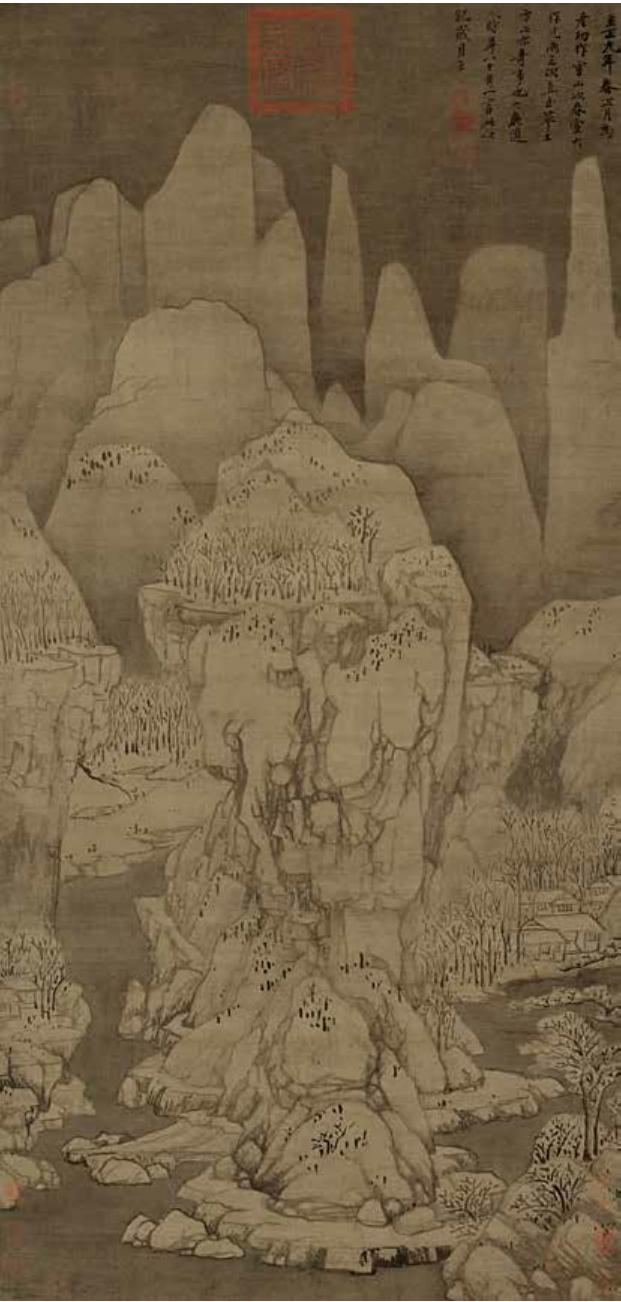Chinese Ink Painting:Fusing Soul and Nature
2021-04-06byLiuWanming
by Liu Wanming
Chinese painting derived from Fuxi Bagua (Eight Trigrams) and Chinese characters and has developed for thousands of years. Traditional Chinese painting is a complete and independent art system deeply rooted in the cultural soil of the Chinese nation and the countrys unique culture, aesthetics, and philosophy.
Chinese painting stresses the aesthetic principle of “abstracting concepts from objects.”The idea influences the dialectical unity of the depiction and creation of Chinese painting. It includes two aspects: observation and absorption. The so-called“object observation” refers to the omni-directional and multi-level observation and understanding of celestial phenomena, geography, animals, and vegetation, as part of an effort to explore the laws of nature and human affairs.“Abstracting concepts” refers to summarizing and displaying the results of observation in the form of symbols. After adoption and discarding, it reflects the unity of depiction and creation. Whether observing surrounding objects or other elements from the vast natural world, “absorption” requires the flexibility to combine understanding of external things with the consciousness of life and integrate life into the universe, which is also essential for the aesthetic creation of Chinese painting.
Chinese painting emphasizes the aesthetics of nature, which originated from Chinese appreciation for the unity of man and nature since ancient times. This unity calls for merging the soul and nature and fusing emotion with its surroundings. The rise of Chinese landscape poetry and painting is the artistic embodiment of the combination of human consciousness and natural aesthetic consciousness.
Another important aesthetic appeal of Chinese painting lies in“viewing art with truth,” which discusses the relationship between“truth” and “skill.” When top-tier art techniques are obtained, art creation will move toward freedom, evolving from art to“truth.” The core goal of “observing art with truth” is to use the concept of “truth” to master skills, control form with spirit, and build soul-to-soul connection instead of observation through the eyes. This is also the ultimate goal of Chinese painting creation.
For the same reason, Chinese painting attaches great importance to the cultivation of the painters personality. Calligraphic works are written with the mind, and paintings are crafted with the heart. A conscious mind will produce great writing, while a candid soul will guide fine art. Su Shi (1037-1101), a renowned writer and painter of the Northern Song Dynasty(960-1127), was broad-minded and detached, so his paintings and calligraphy demonstrate a strong sense of freedom and uprightness. Qian Xuan (1235-?), a Southern Song Dynasty (1127-1279) painter, was well versed in painting figures, landscapes, flowers and birds. His paintings are mild and meaningful due to his broad-minded temperament and magnanimous style. Mi Fu (1051-1107), a prestigious calligrapher and painter of the Northern Song Dynasty, left many calligraphic works characterized by elegance and aloofness. Xu Wei (1521-1593), a famous calligrapher and painter of the Ming Dynasty (1368-1644), had a unique temperament. Upholding the rule of conforming to nature, his paintings were flush with vitality and free of vulgarity.

Meanwhile, Chinese painting also requires the painters artistic concept to serve as a corner stone. It advocates reading before painting. A speck of dust in the mind might rust the brush pen. Only through years of practice can a painting master be born. Guo Ruoxu from the Northern Song Dynasty believed that moral standing was a crucial component of quality art. Dong Qichang(1555-1636), a calligrapher and painter from the Ming Dynasty, said that only after reading ten thousand books and traveling ten thousand miles should one attempt to paint. Such practitioners aimed to present characters through painting and calligraphy and enhance education and emotional ties with art.
Chinese painting emphasizes beauty and benevolence while appreciating personality, with themes focusing on peace and harmony. Most works are meditative and calming. They explore the effects of emotions on the soul to implement the beauty of “balance and harmony.”